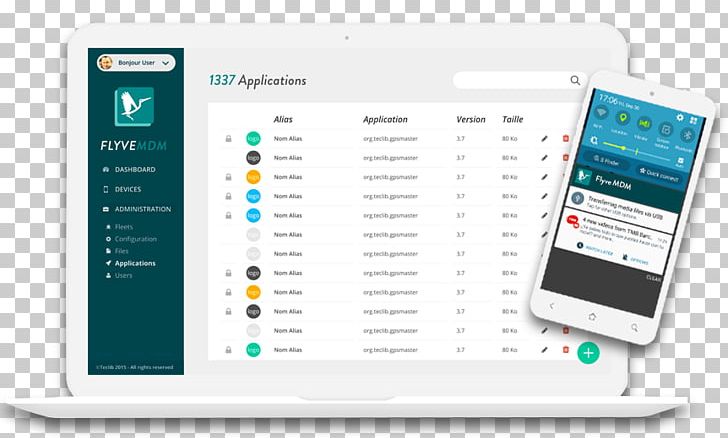Mobile application management open source
After the enrollment completes, the store app can push configuration, some device level policies for enforcement, and any required applications. Mobile application management MAM is a technology that primarily focuses on enforcing policies on mobile applications. To be able to have this finer level control over applications, an organization needs to wrap the application. The injected code can then listen for events that are related to certain policies.

For example, if an application is not allowed to open the camera application, then the injected code will listen for the corresponding events that will bring up the camera. How this is done is different on Android and iOS because the platforms handle these kinds things quite differently.
GitHub - florent37/Open-Mam: Open Source Mobile Application Management (WORK IN PROGRESS)
With respect to features, both offer single-sign on SSO , a suite of productivity apps email, browser, etc. However, AirWatch also allows management of the native email clients on Android and iOS which tends to be buggier. In terms of the administration web app, XenMobile is a bit more complicated than AirWatch and may require a few tech support calls to get configured just right. Both products require mobile apps to be wrapped with a wrapping utility before they can be uploaded to the management console.
Also, both products have great VPN capabilities. If your organization is already using Netscaler than it might make more sense to use XenMobile.
A complete MDM solution for your business needs:
Netscaler appears to be more feature-rich compared to VMware Tunnel, but Netscaler is also very hard to configure. With respect to price, AirWatch tends to be cheaper for smaller organizations than XenMobile because XenMobile offers fixed price tiers where as AirWatch has a per-device pricing model. However, this also makes it a bit more simpler and easier to administrate. If your organization needs expert-level consulting then we are available to help you! End Point. Enterprise Security. Custom Applications. Managed Infrastructure.
About Us. Our Team. Contact Us. What is MDM? Some of the useful things you can do with MDM: Install apps autonomously: Some corporations have their own suite of mobile applications that they require all employees to use. MDM allows organizations to push down required apps to a device. Sima is quick to point out, though, that mobile devices are more personal, unlike laptops or other endpoints.
Next, organizations enter the app-centric phase. Because enterprises may not necessarily own the mobile device, they must decide whether they position everything around the device or around the app. Sima explains app-centric thinking as:. Sima sees organizations today at the peak of device-centric security.
He says device security is easy to adapt and control, and there's no high learning curve. Going with app-first mobile security can take the form of cloud platforms outside the corporate firewall, consumer apps protecting transaction data, and application development best practices. Cohen also likes Office for mobile users because of enforcement rules that enables administrators to lock down corporate documents from ever being downloaded to personal devices. App-first security will always win with consumer apps.
An Introduction to Open Source Platforms for Developing Mobile Applications
Sima uses the example of a mobile bank app connecting a customer to an endpoint or service. Crowley recommends mobile application management MAM for corporate-developed or purchased applications provided to employees, contractors, and business partners. He explains that containerized protection of applications and the associated data allows the organization to affect those apps and data. The organization owns the data and needs to assert management of that data.
In-app customer support has never been easier
Crowley sees an EMM strategy as a compelling and straightforward solution for corporate-owned devices. He explains:. This also includes an opportunity for escrow of credential information and backups of devices to prevent data loss in the event of loss or theft. That's because mobile users will have to access the network to access shared resources, making device-centric security a necessity.
App-first mobile security: Is it time to ditch mobile management?
He also suggests that a BYOD strategy may no longer be cost effective or advantageous to some organizations, adding that many businesses may not have the needed maturity or discipline and will continue to struggle with corporate-issued versus BYOD solutions. Recent victors in the ongoing MDM and EMM market consolidation have been larger companies, but an established enterprise security vendor has yet to pull mobility management into its product portfolio.
In terms of this potential market change, Cohen dices up a future EMM market into three vendor tiers:. Cohen sees a future where traditional security vendors with existing reputations for securing corporate networks make more moves into the EMM market. It could be one way that EMM keeps the potential of app-first mobile security at bay, given the wide reach and influence of these vendors.
- sony xperia sola update 4.1.
- LogicalDOC Mobile Applications?
- download mp4 songs for ipad;
- Don't ship your app without HelpStack!.
- will kindle hdx run android apps.
- Mobile application management - Wikipedia?
- latest samsung phones under 20000.
EMM management would no longer be a separate product offering, but rather another element of a larger network-level security platform. Whether or not to ditch mobile management suites will remain a question organizations must answer for themselves. Nolan Wright, CTO and co-founder of Appcelerator, recommends that organizations trying to decide between app-first and a mobile management solution be real clear on their vulnerabilities and map to solutions that will secure their corporate information across devices.
Part of that decision-making process could include charting where your organization sits in the stages of device-centric, app-centric, and data-centric security.